key TOYOTA YARIS 2013 User Guide
[x] Cancel search | Manufacturer: TOYOTA, Model Year: 2013, Model line: YARIS, Model: TOYOTA YARIS 2013Pages: 712, PDF Size: 30.2 MB
Page 66 of 712
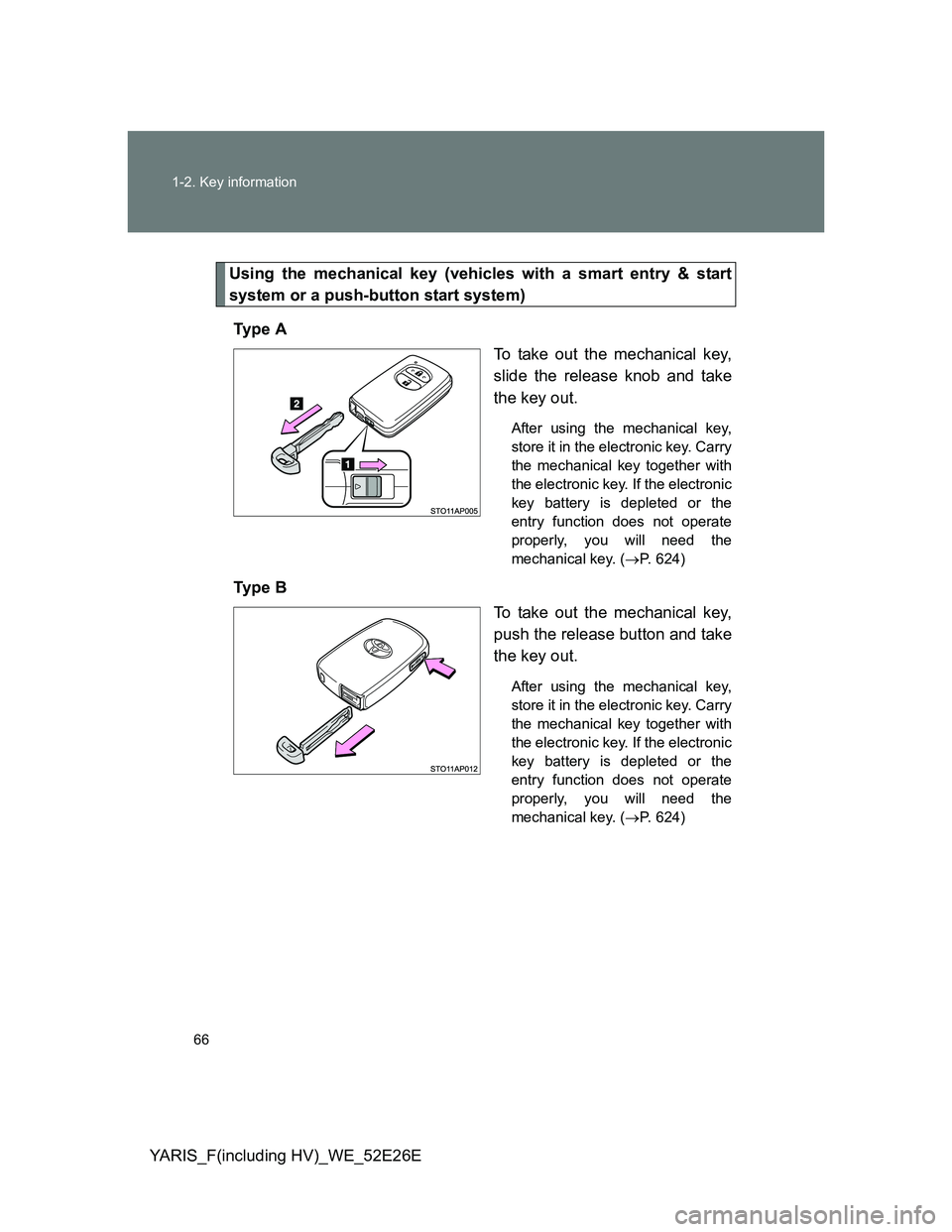
66 1-2. Key information
YARIS_F(including HV)_WE_52E26E
Using the mechanical key (vehicles with a smart entry & start
system or a push-button start system)
Ty p e A
To take out the mechanical key,
slide the release knob and take
the key out.
After using the mechanical key,
store it in the electronic key. Carry
the mechanical key together with
the electronic key. If the electronic
key battery is depleted or the
entry function does not operate
properly, you will need the
mechanical key. (P. 624)
Ty p e B
To take out the mechanical key,
push the release button and take
the key out.
After using the mechanical key,
store it in the electronic key. Carry
the mechanical key together with
the electronic key. If the electronic
key battery is depleted or the
entry function does not operate
properly, you will need the
mechanical key. (P. 624)
Page 67 of 712
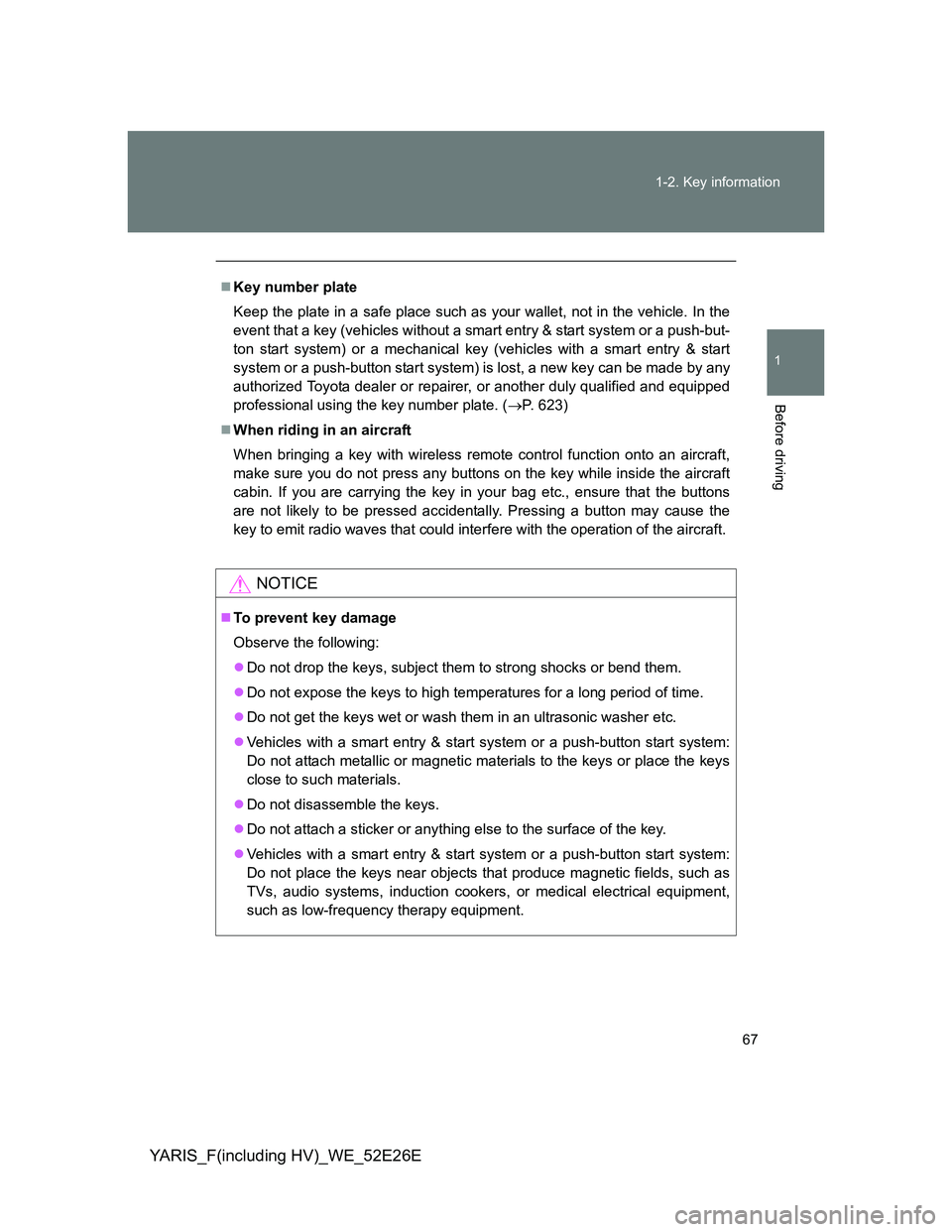
67 1-2. Key information
1
Before driving
YARIS_F(including HV)_WE_52E26E
Key number plate
Keep the plate in a safe place such as your wallet, not in the vehicle. In the
event that a key (vehicles without a smart entry & start system or a push-but-
ton start system) or a mechanical key (vehicles with a smart entry & start
system or a push-button start system) is lost, a new key can be made by any
authorized Toyota dealer or repairer, or another duly qualified and equipped
professional using the key number plate. (P. 623)
When riding in an aircraft
When bringing a key with wireless remote control function onto an aircraft,
make sure you do not press any buttons on the key while inside the aircraft
cabin. If you are carrying the key in your bag etc., ensure that the buttons
are not likely to be pressed accidentally. Pressing a button may cause the
key to emit radio waves that could interfere with the operation of the aircraft.
NOTICE
To prevent key damage
Observe the following:
Do not drop the keys, subject them to strong shocks or bend them.
Do not expose the keys to high temperatures for a long period of time.
Do not get the keys wet or wash them in an ultrasonic washer etc.
Vehicles with a smart entry & start system or a push-button start system:
Do not attach metallic or magnetic materials to the keys or place the keys
close to such materials.
Do not disassemble the keys.
Do not attach a sticker or anything else to the surface of the key.
Vehicles with a smart entry & start system or a push-button start system:
Do not place the keys near objects that produce magnetic fields, such as
TVs, audio systems, induction cookers, or medical electrical equipment,
such as low-frequency therapy equipment.
Page 68 of 712
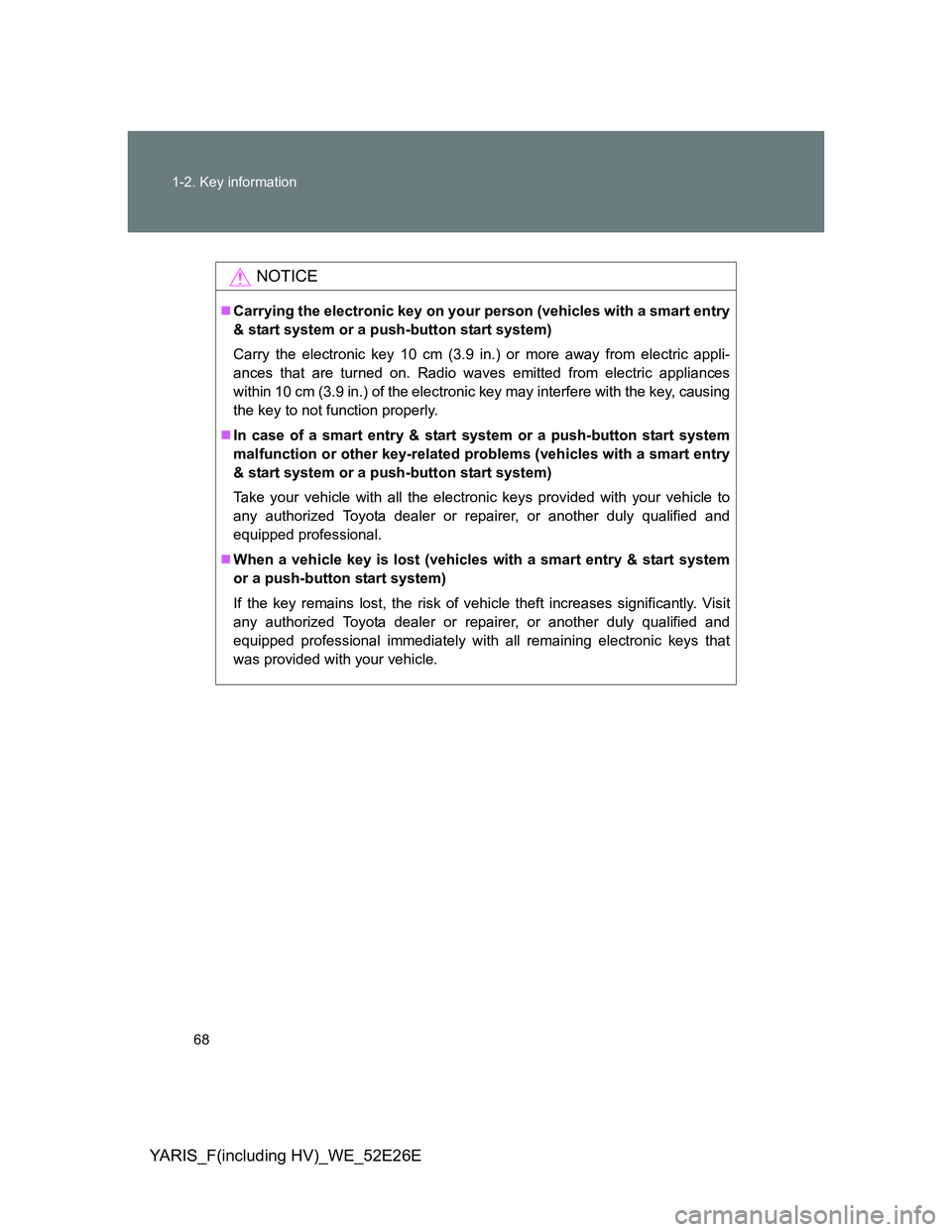
68 1-2. Key information
YARIS_F(including HV)_WE_52E26E
NOTICE
Carrying the electronic key on your person (vehicles with a smart entry
& start system or a push-button start system)
Carry the electronic key 10 cm (3.9 in.) or more away from electric appli-
ances that are turned on. Radio waves emitted from electric appliances
within 10 cm (3.9 in.) of the electronic key may interfere with the key, causing
the key to not function properly.
In case of a smart entry & start system or a push-button start system
malfunction or other key-related problems (vehicles with a smart entry
& start system or a push-button start system)
Take your vehicle with all the electronic keys provided with your vehicle to
any authorized Toyota dealer or repairer, or another duly qualified and
equipped professional.
When a vehicle key is lost (vehicles with a smart entry & start system
or a push-button start system)
If the key remains lost, the risk of vehicle theft increases significantly. Visit
any authorized Toyota dealer or repairer, or another duly qualified and
equipped professional immediately with all remaining electronic keys that
was provided with your vehicle.
Page 69 of 712
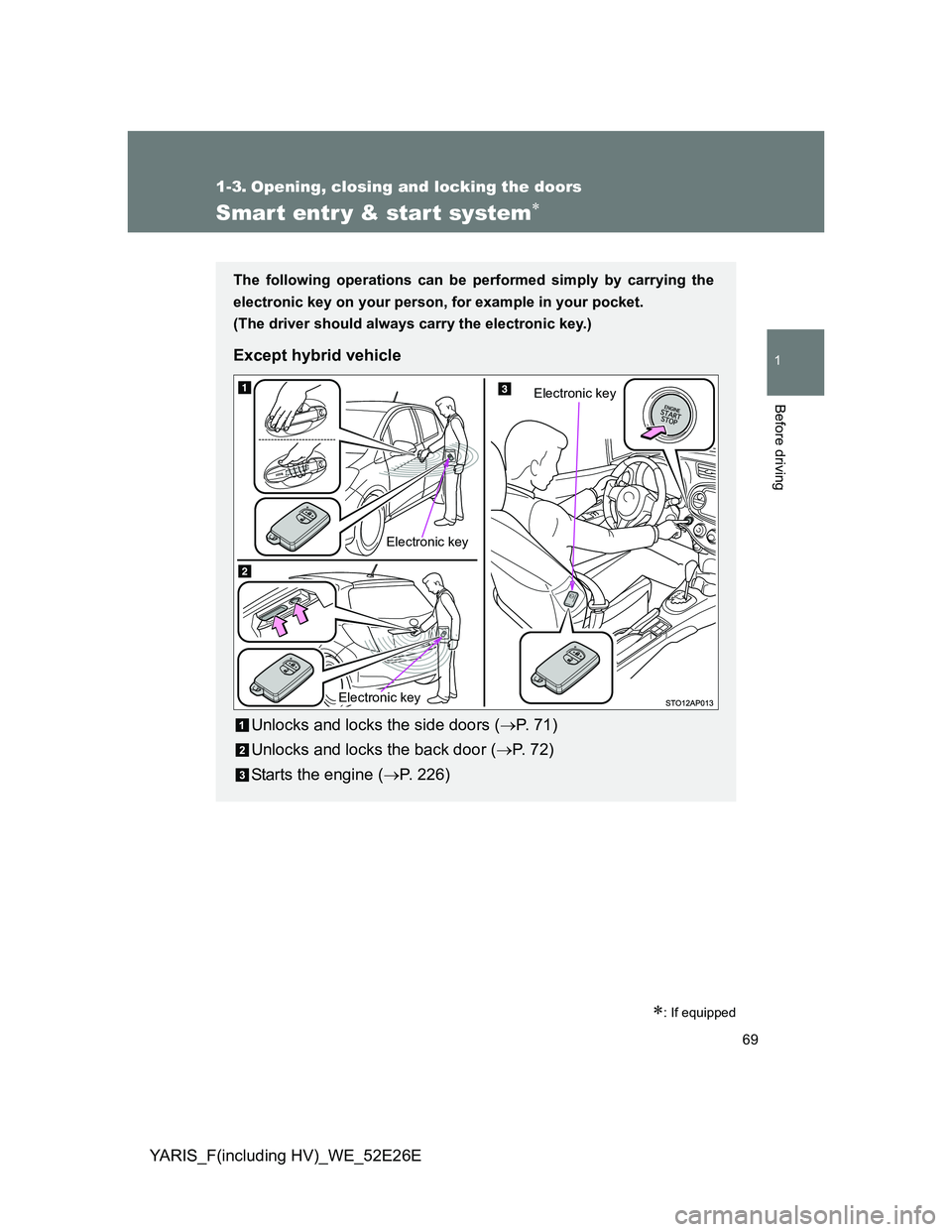
69
1
Before driving
YARIS_F(including HV)_WE_52E26E
1-3. Opening, closing and locking the doors
Smart entr y & start system
: If equipped
The following operations can be performed simply by carrying the
electronic key on your person, for example in your pocket.
(The driver should always carry the electronic key.)
Except hybrid vehicle
Unlocks and locks the side doors (P. 7 1 )
Unlocks and locks the back door (P. 72)
Starts the engine (P. 226)
Electronic key
Electronic keyElectronic key
Page 70 of 712
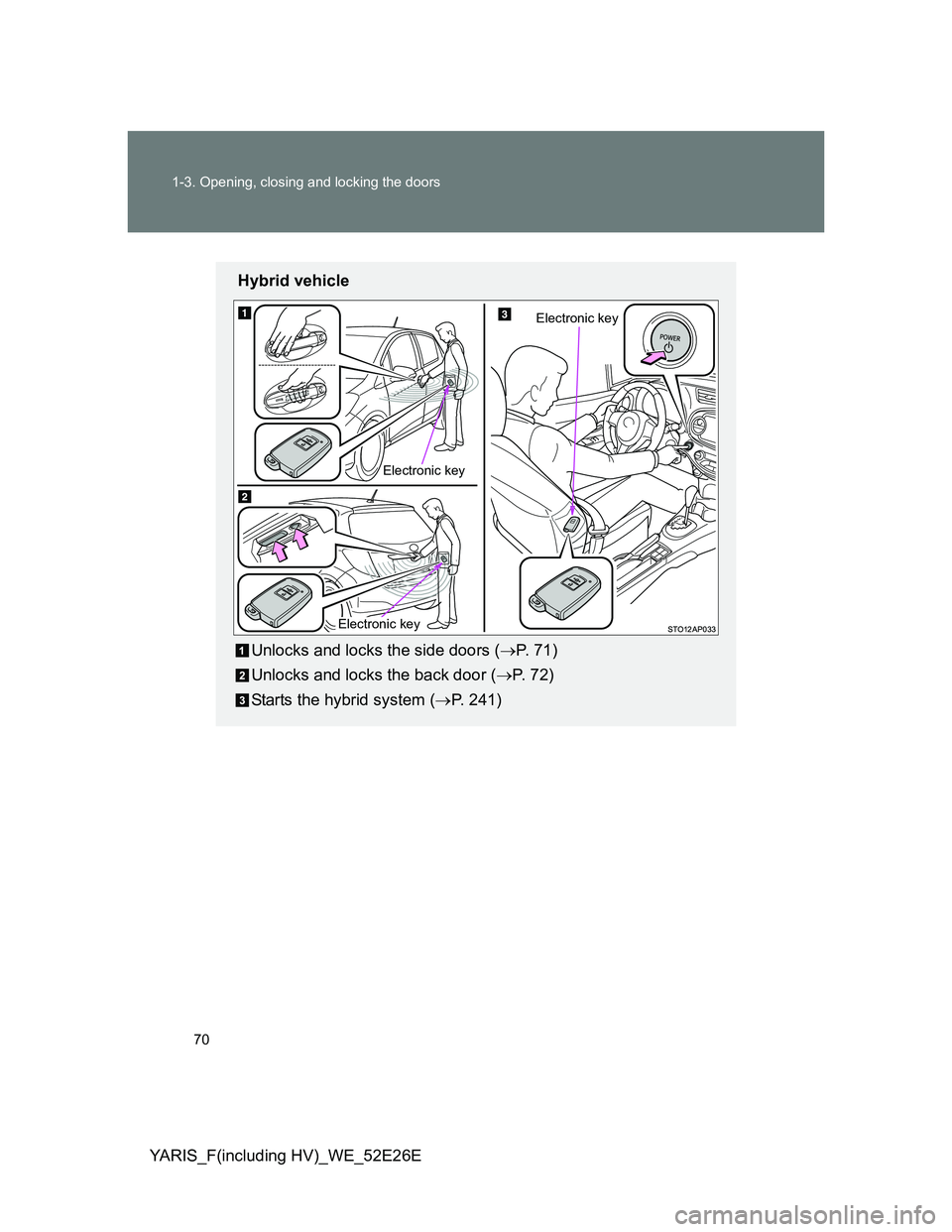
70 1-3. Opening, closing and locking the doors
YARIS_F(including HV)_WE_52E26E
Hybrid vehicle
Unlocks and locks the side doors (P. 7 1 )
Unlocks and locks the back door (P. 72)
Starts the hybrid system (P. 241)
Electronic key
Electronic key
Electronic key
Page 74 of 712
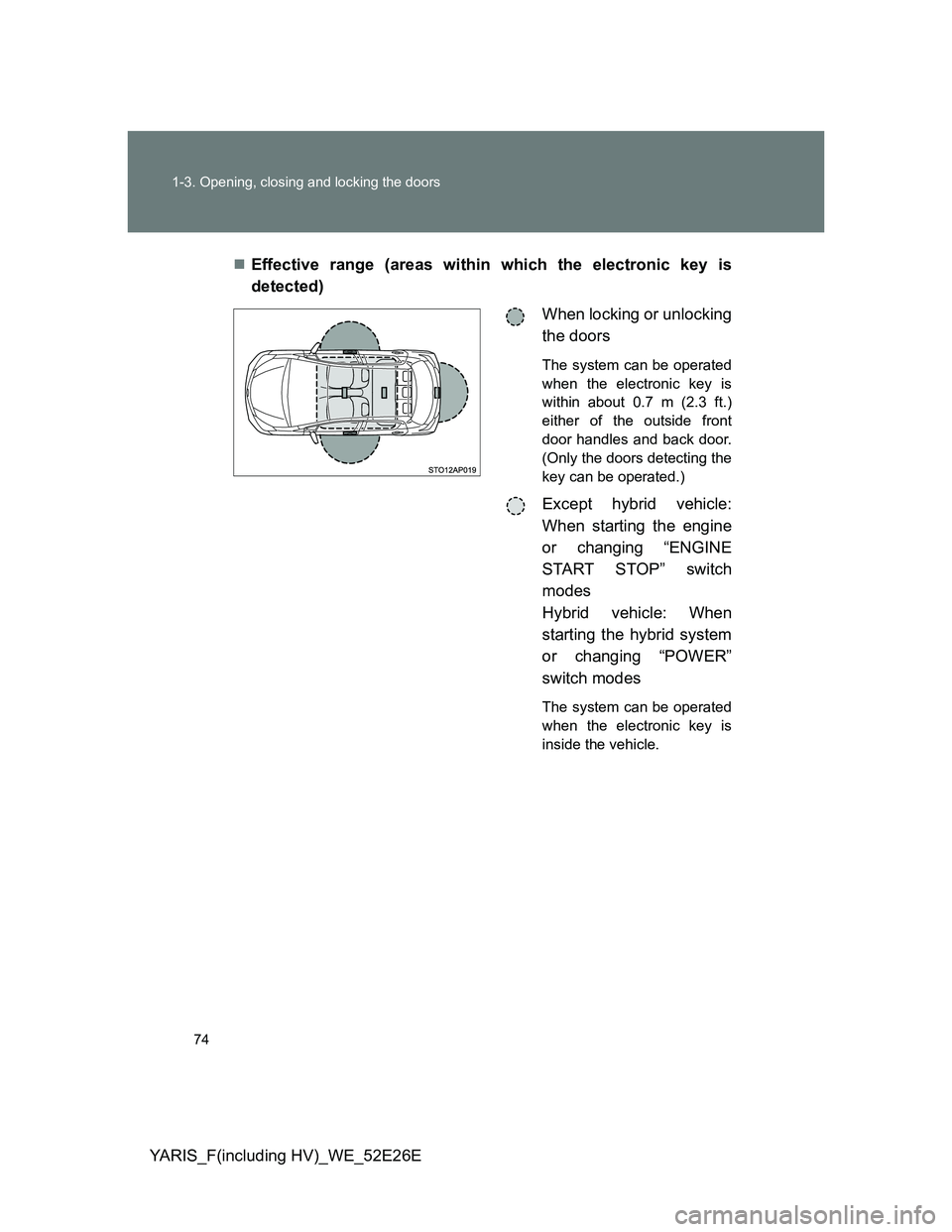
74 1-3. Opening, closing and locking the doors
YARIS_F(including HV)_WE_52E26EEffective range (areas within which the electronic key is
detected)
When locking or unlocking
the doors
The system can be operated
when the electronic key is
within about 0.7 m (2.3 ft.)
either of the outside front
door handles and back door.
(Only the doors detecting the
key can be operated.)
Except hybrid vehicle:
When starting the engine
or changing “ENGINE
START STOP” switch
modes
Hybrid vehicle: When
starting the hybrid system
or changing “POWER”
switch modes
The system can be operated
when the electronic key is
inside the vehicle.
Page 75 of 712
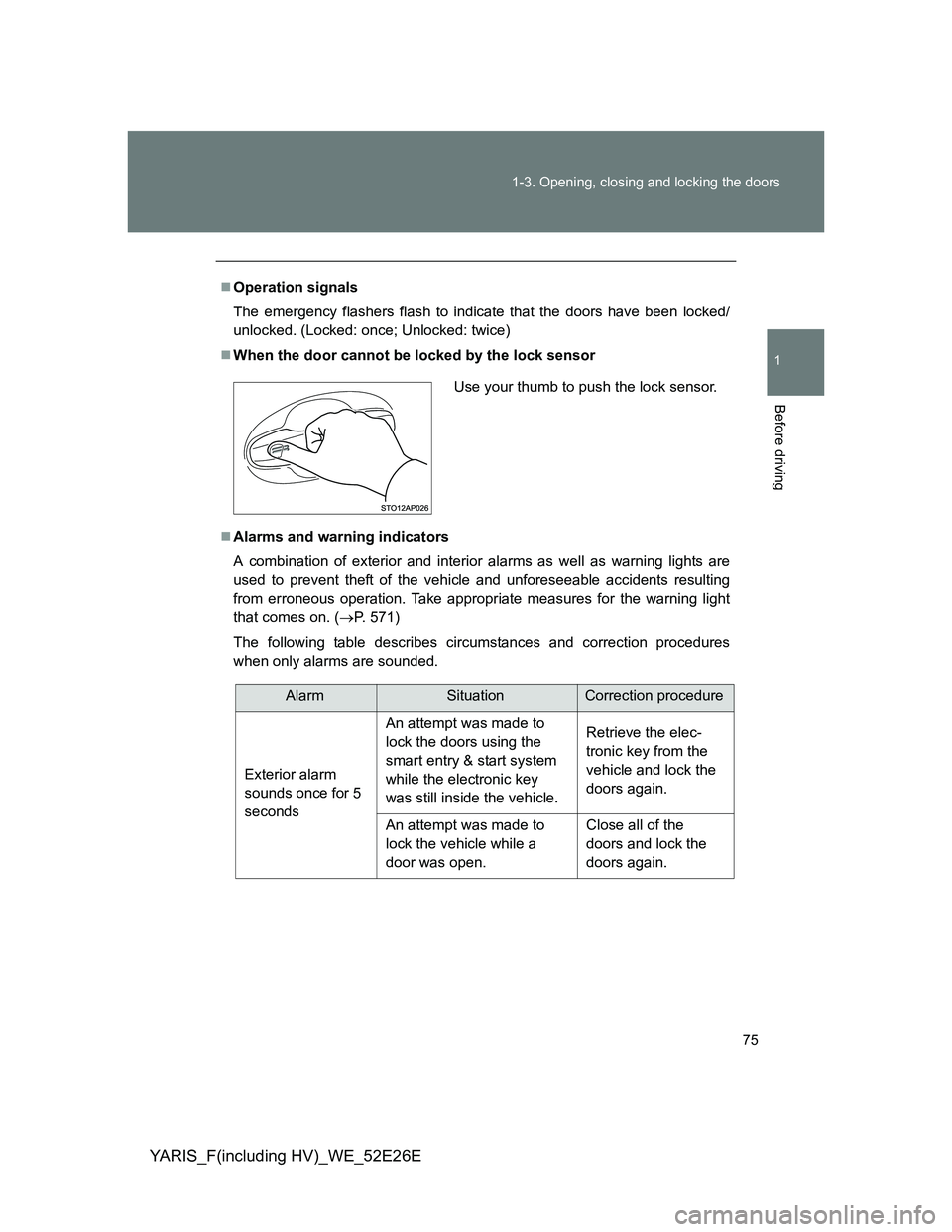
75 1-3. Opening, closing and locking the doors
1
Before driving
YARIS_F(including HV)_WE_52E26E
Operation signals
The emergency flashers flash to indicate that the doors have been locked/
unlocked. (Locked: once; Unlocked: twice)
When the door cannot be locked by the lock sensor
Alarms and warning indicators
A combination of exterior and interior alarms as well as warning lights are
used to prevent theft of the vehicle and unforeseeable accidents resulting
from erroneous operation. Take appropriate measures for the warning light
that comes on. (P. 571)
The following table describes circumstances and correction procedures
when only alarms are sounded.
Use your thumb to push the lock sensor.
AlarmSituationCorrection procedure
Exterior alarm
sounds once for 5
secondsAn attempt was made to
lock the doors using the
smart entry & start system
while the electronic key
was still inside the vehicle.Retrieve the elec-
tronic key from the
vehicle and lock the
doors again.
An attempt was made to
lock the vehicle while a
door was open.Close all of the
doors and lock the
doors again.
Page 76 of 712
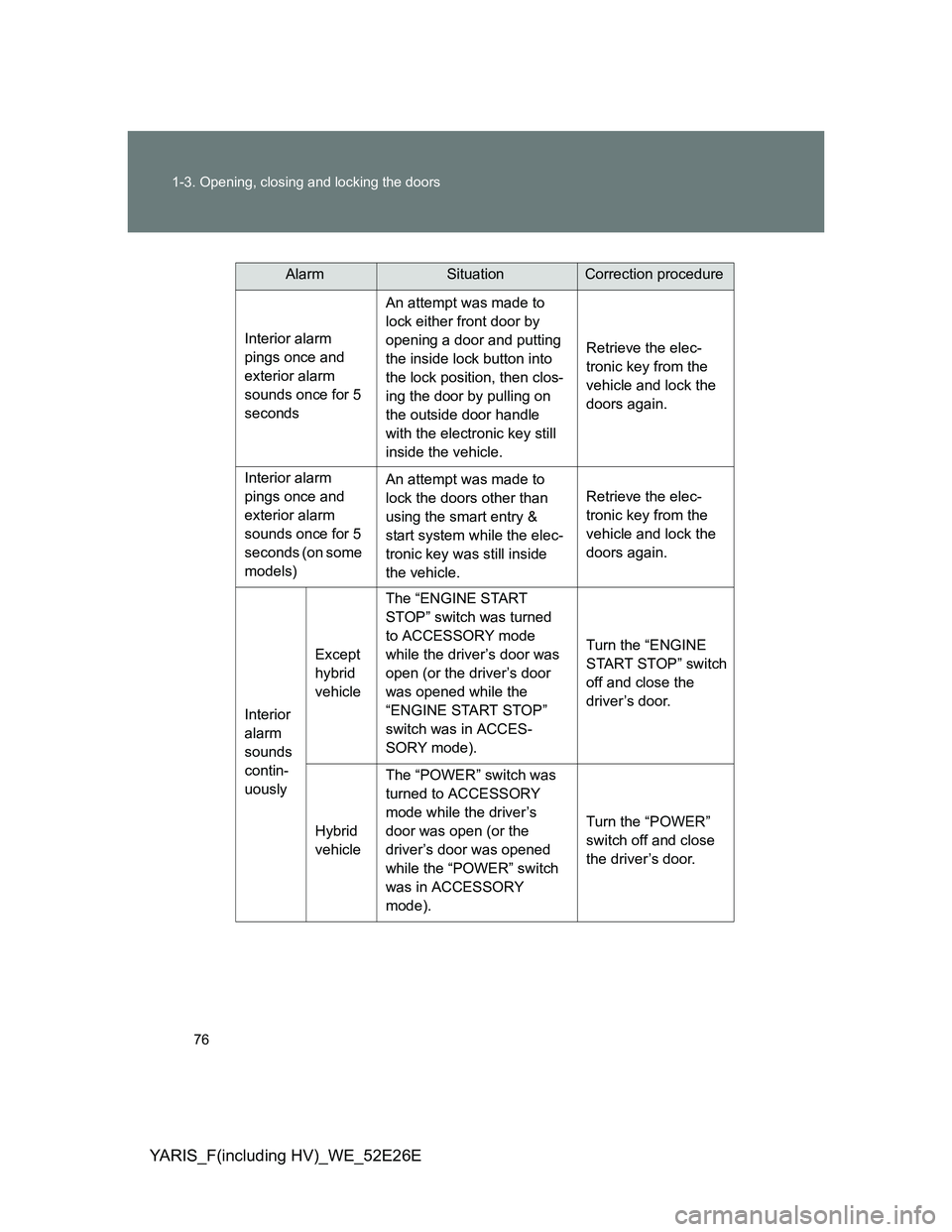
76 1-3. Opening, closing and locking the doors
YARIS_F(including HV)_WE_52E26E
AlarmSituationCorrection procedure
Interior alarm
pings once and
exterior alarm
sounds once for 5
secondsAn attempt was made to
lock either front door by
opening a door and putting
the inside lock button into
the lock position, then clos-
ing the door by pulling on
the outside door handle
with the electronic key still
inside the vehicle.Retrieve the elec-
tronic key from the
vehicle and lock the
doors again.
Interior alarm
pings once and
exterior alarm
sounds once for 5
seconds (on some
models)An attempt was made to
lock the doors other than
using the smart entry &
start system while the elec-
tronic key was still inside
the vehicle.Retrieve the elec-
tronic key from the
vehicle and lock the
doors again.
Interior
alarm
sounds
contin-
uouslyExcept
hybrid
vehicleThe “ENGINE START
STOP” switch was turned
to ACCESSORY mode
while the driver’s door was
open (or the driver’s door
was opened while the
“ENGINE START STOP”
switch was in ACCES-
SORY mode).Turn the “ENGINE
START STOP” switch
off and close the
driver’s door.
Hybrid
vehicleThe “POWER” switch was
turned to ACCESSORY
mode while the driver’s
door was open (or the
driver’s door was opened
while the “POWER” switch
was in ACCESSORY
mode).Turn the “POWER”
switch off and close
the driver’s door.
Page 77 of 712
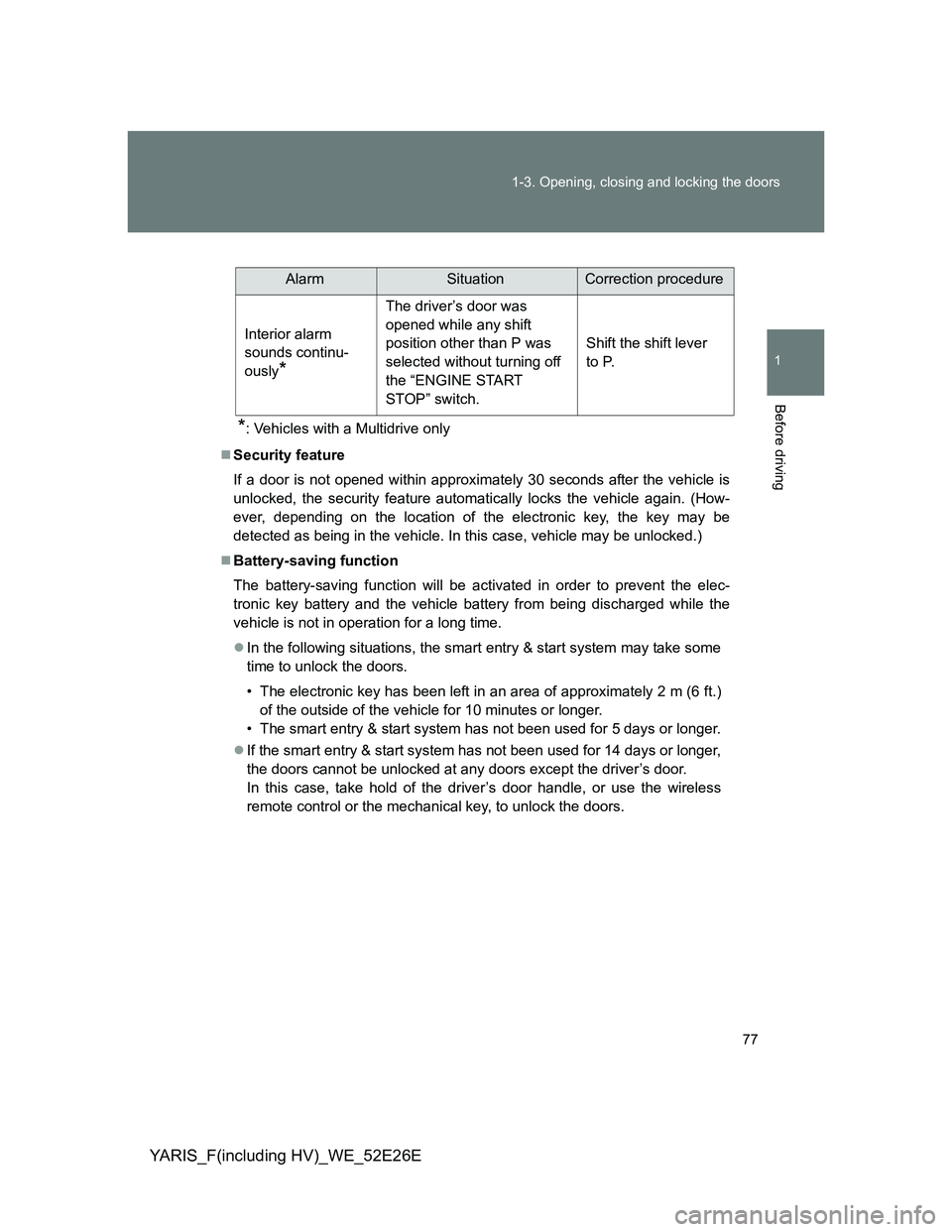
77 1-3. Opening, closing and locking the doors
1
Before driving
YARIS_F(including HV)_WE_52E26E
*: Vehicles with a Multidrive only
Security feature
If a door is not opened within approximately 30 seconds after the vehicle is
unlocked, the security feature automatically locks the vehicle again. (How-
ever, depending on the location of the electronic key, the key may be
detected as being in the vehicle. In this case, vehicle may be unlocked.)
Battery-saving function
The battery-saving function will be activated in order to prevent the elec-
tronic key battery and the vehicle battery from being discharged while the
vehicle is not in operation for a long time.
In the following situations, the smart entry & start system may take some
time to unlock the doors.
• The electronic key has been left in an area of approximately 2 m (6 ft.)
of the outside of the vehicle for 10 minutes or longer.
• The smart entry & start system has not been used for 5 days or longer.
If the smart entry & start system has not been used for 14 days or longer,
the doors cannot be unlocked at any doors except the driver’s door.
In this case, take hold of the driver’s door handle, or use the wireless
remote control or the mechanical key, to unlock the doors.
AlarmSituationCorrection procedure
Interior alarm
sounds continu-
ously
*
The driver’s door was
opened while any shift
position other than P was
selected without turning off
the “ENGINE START
STOP” switch.Shift the shift lever
to P.
Page 78 of 712
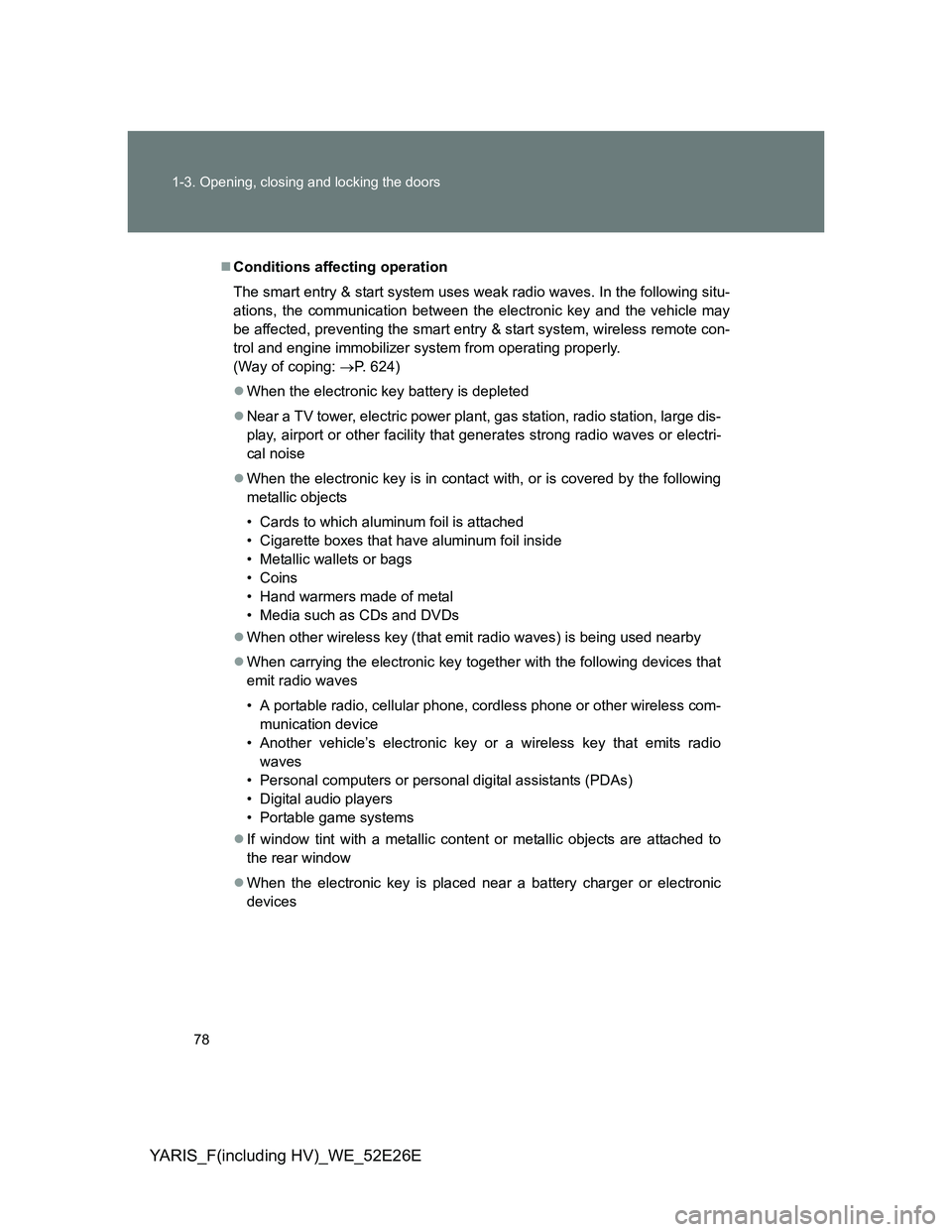
78 1-3. Opening, closing and locking the doors
YARIS_F(including HV)_WE_52E26E
Conditions affecting operation
The smart entry & start system uses weak radio waves. In the following situ-
ations, the communication between the electronic key and the vehicle may
be affected, preventing the smart entry & start system, wireless remote con-
trol and engine immobilizer system from operating properly.
(Way of coping: P. 624)
When the electronic key battery is depleted
Near a TV tower, electric power plant, gas station, radio station, large dis-
play, airport or other facility that generates strong radio waves or electri-
cal noise
When the electronic key is in contact with, or is covered by the following
metallic objects
• Cards to which aluminum foil is attached
• Cigarette boxes that have aluminum foil inside
• Metallic wallets or bags
• Coins
• Hand warmers made of metal
• Media such as CDs and DVDs
When other wireless key (that emit radio waves) is being used nearby
When carrying the electronic key together with the following devices that
emit radio waves
• A portable radio, cellular phone, cordless phone or other wireless com-
munication device
• Another vehicle’s electronic key or a wireless key that emits radio
waves
• Personal computers or personal digital assistants (PDAs)
• Digital audio players
• Portable game systems
If window tint with a metallic content or metallic objects are attached to
the rear window
When the electronic key is placed near a battery charger or electronic
devices